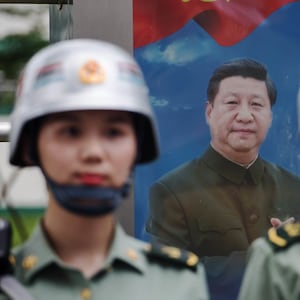HONG KONG—In a rare act of bipartisanship, Taiwan’s Democratic Progressive Party (DPP) and the opposition Kuomintang (KMT) passed a resolution on Tuesday calling for the Taiwanese Ministry of Foreign Affairs to reestablish formal diplomatic relations with the United States, two and a half weeks after Chinese state media issued a threat against the personal safety of Taiwan’s president.
Multiple factors explain the two parties’ support for the bill, and they all point to the Chinese Communist Party’s aggression toward Taiwan. Every day for more than two weeks, warplanes dispatched by China’s People’s Liberation Army Air Force breached Taiwan’s air defense identification zone—airspace that has been managed by Taiwan since the end of World War II.
These fly-bys are part of a sustained campaign by Beijing to provoke military reactions from Taiwan and one of its closest allies, the United States, which maintains a naval presence in the Taiwan Strait. Chinese warships routinely conduct drills in the same waters.
ADVERTISEMENT
But recent saber-rattling has been rising to a crescendo. CCP-backed nationalistic outlet Global Times said in September that Taiwanese president Tsai Ing-wen is “playing with fire” by hosting a senior U.S. State Department official in Taipei, and that “a war will be set off” if Taiwan continues down its path of democratic governance and self-determination, ending with Tsai being “wiped out.”
Read that as a direct threat of violence made on a state-affiliated social media account against a democratically elected national leader.
After recent visits by U.S. Health and Human Services Secretary Alex Azar to Taiwan in early August—the highest-ranking American official to travel to the island since 1979—and then State Department envoy Keith Krach’s stop in Taipei in mid-September, Taiwanese legislators want their foreign ministry to lean on the U.S. to “help resist the CCP.”
At the moment, the United States does not recognize Taiwan as a country, but regularly supplies military equipment to the Taiwanese military for defense purposes.
The Daily Beast has reached out to current and former Taiwanese diplomats, including foreign minister Joseph Wu, but has not received a response regarding the landmark resolution or the ministry’s next steps.
Taiwan is a subject of obsession among CCP leadership. To annex its main island—which Beijing sees as part of “One China”—would cement the legacy of a party leader with revanchist predilections. In January 2019, CCP leader Xi Jinping said in a speech to party officials and military officers that China is “growing strong, the nation is rejuvenating, and unification between the two sides of the Strait is the great trend of history.”
That’s all to say that Beijing is ready to mobilize troops rather than tolerate an independent Taiwanese nation. One possible path to “reunification” that cannot be ignored is a hostile takeover or open war, specifically a military invasion by the People’s Liberation Army (PLA) to conquer and take control of Taiwan, a nation of nearly 24 million people, by sea and air.
This specter has led to massive and frequent arms acquisitions by Taiwanese authorities. In September, the Trump administration approved plans to sell $7 billion worth of weapons and military equipment to Taiwan, coinciding with elevated provocation by Chinese forces in the Taiwan Strait. The deal covers sea mines, drones, and cruise missiles as part of the second largest weapons sale from the U.S. to the island nation, just $1 billion shy of Taiwan’s purchase made last year.
A preference of individually cheaper armaments over flashy, big-ticket items like fighter jets fits the Taiwanese military’s adoption of asymmetric defense measures in preparation for armed conflict with Chinese forces.
Last year, speaking to The Daily Beast, Holmes Liao, the coordinator of security technologies at Taipei’s Prospect Foundation, a research institute that focuses on foreign policy and international affairs, said the Taiwanese military’s defense strategy has shifted from actively disrupting Chinese forces to “anticipate an invasion from the Strait and then to defeat the enemy on the beach.” The core idea is to make it extremely costly for the PLA to eliminate Taiwan’s defenses and to discourage an invasion.
Whether or not Taiwan’s foreign ministry actively probes the possibility of establishing renewed diplomatic relations with the United States, the Trump administration is unlikely to recognize Taiwan’s sovereignty explicitly, because doing so may lead to a full break with Beijing, which is an outcome that even most China hawks wish to avoid. In his book The Room Where It Happened, former national security adviser John Bolton wrote that Trump is “particularly dyspeptic about Taiwan.”
Nonetheless, the Taiwan Strait is where China and the U.S. constantly send military signals to each other, making it a stretch of air and sea where armed conflict between the two superpowers is most likely to take place. Lately, those signals have been getting hotter, and recent developments suggest China’s PLA is ready to escalate tensions in the region to probe exactly how far the U.S. is willing to go to maintain its naval presence near Taiwan—and mainland China.
In the meantime, the people of Taiwan are caught in the crossfire. As each day passes, that metaphor inches closer to reality.







